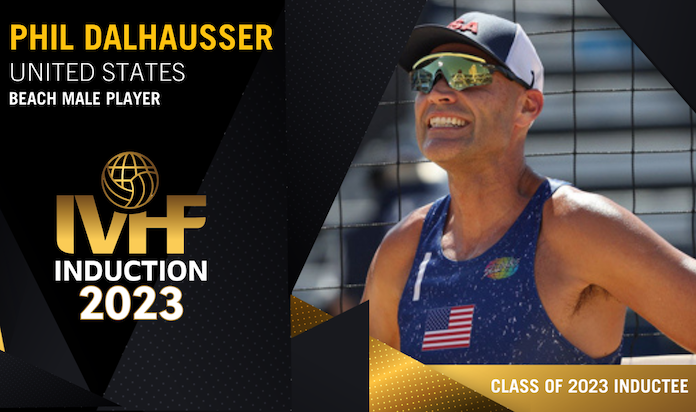
International Volleyball Hall induction week: USA beach legend Phil Dalhausser
It’s induction week at the International Volleyball Hall of Fame in Holyoke, Massachusetts. The ceremony is Saturday. Six inductees will join the previous 161 players, coaches, administrators and leaders from 25 countries who have already been enshrined in the museum at the birthplace of volleyball:
One match changed everything in the life of Phil Dalhausser.
And the residual effect of that one three-setter altered the course of beach volleyball forever.
It was Friday July 23, 2004, in Hermosa Beach, California. The second round of the winners bracket in the eponymously named Open. Beach volleyball royalty Karch Kiraly and his partner Mike Lambert on one side of the net and the upstarts, Dalhausser and Nick Lucena, both just 24, and relatively unknown, especially along the California coast, on the other.
It was the 2004 AVP team of the year, the No. 1 seed, against the 16th. A layup if there ever was one.
Only someone forget to tell the kids from Florida.
They lost the first set 21-16, but were undeterred. They rebounded in the second. Suddenly, a crowd started forming and distinct murmurs could be heard. Who is that giant? The skinny bald guy? He can do everything, he’s coordinated! What, he’s from Florida??? No way! And the murmurs became a roar that could be heard all the way from Hermosa to the world over as Dalhausser and Lucena toppled Kiraly and Lambo 15-9 in the decisive third set.
The tectonic plates of beach volleyball shifted that day in Hermosa, and the resulting earthquake was felt from sea to shining sea.
Phil Dalhausser/ and Nick Lucena celebrate gold in Hamburg in 2016
“It hit me that I can make a career out of this,” Dalhausser reflected 19 years later. “We beat Stein (Metzger) and Dax (Holdren) and Jeff (Nygaard) and Dain (Blanton) in that tournament. Those two teams represented the USA in the Olympics later that summer. And we beat the great Karch Kiraly.”
Dalhausser changed the game in so many ways. Never had a man of his size (6-foot-9) possessed the repertoire of skills that he displayed. He could pass nails (that is on the few times he ever got served). His setting was butter, even with the ball spinning like a dreidel, the sun in his eyes, the wind in his face and the ball slippery wet from sweat. Nobody could block his hits, and in turn, he put up a wall, despite his skinny frame, that was the hardest to penetrate of any protagonist in the world on the sand. His jump serve was money. He had amazing quickness, and could pull off the block very effectively. And for those who doubted his defensive bona fides, he won an AVP with young Andy Benesh in 2022, split blocking.
You simply cannot underestimate the impact of this uber-coordinated 6-9 player who could pass, set, hit, block and commanded a laser-like jump serve.
And, for a sport whose origins were in Southern California, Dalhausser and Lucena paved the way and showed it was possible that you did not have to be from, or move to, SoCal to be a force. Consider that right now, one of the top USA women’s team features Taryn Kloth, who is from South Dakota, and her partner Kristen Nuss, who is from Louisiana.
Dalhausser and Lucena first showed it could be done.
Dalhausser also had other gifts, less visible, but no less impactful. Take for instance his preternatural calm in the face of adversity. That adversity was no more apparent than in the first round of the single-elimination winners bracket at the 2008 Olympics in Beijing. A loss would have sent second-seeded Dalhausser and his partner, Todd Rogers, to a dispiriting ninth place.
And it looked like a loss was in the offing against the No. 20 seeds from Switzerland, Martin Laciga and Jan Schnider. In what should have been a walkover, the Americans split the first two sets, and then found themselves down 6-0 in the set to 15 that would determine the winner.
“We sided out finally,” Dalhausser recalled. “Then I blocked Jan down the line. (Up to that point) he was sneaking these little hits down the line and I finally got him. And Martin freaked out right there and called a timeout. And that timeout changed the momentum in our favor, because he had such an emotional reaction, and then I knew right there we had a chance. Maybe we could get to a 6-9 switch and we would be OK. And it was actually 7-8. Martin was riding his guy Jan, and he (Jan) just kind of caved. The pressure of this match, facing the No. 1 team in the world, and then this guy was riding him in the most negative way possible, and it was too much to handle.”
Phil Dalhausser celebrate after winning the 2008 gold medal in Beijing/Ed Chan, VBshots.com
It’s in these types of moments where gold medals are won. A lot of people will remember Dalhausser’s and Rogers’ surprising first-round Beijing Olympic pool-play loss to Latvia’s Martins Plavins and Alexsandrs Samoilovs. Or the gold-medal match, where the Americans took down Marcio and Fabio of Brazil.
But no match in the life of Phil Dalhausser epitomized his career more than that win over Laciga and Schnider. No panic, the ability to turn it on a dime when it mattered most, and the way his blocking prowess “moved the cheese” of his opponents.
The “Thin Beast,” or “Beijing Beast,” if you prefer, was born 43 years ago in Basel, Switzerland, where he resided for only one year, but has strong and enduring connections to the country. The Dalhausser family also spent some time in Alaska, before they settled in Daytona Beach, Florida. It was Dalhausser’s high school coach, Todd White, a fine beach player in his own right, who introduced Phil to the sand game.
“I only played one year in high school, and he (White) would take us down to the beach. White taught me how to set. How to make it as quiet as possible, the ball hitting your hands, and no spin. I got so many reps in my career. There was only one person who set more balls than me (in their career) and it was Randy Stoklos because they played two-hour matches back in those days (1970s, ‘80s and ‘90s).”
While White got Dalhausser started in the right direction. His trajectory really took off following his college days at Central Florida, when he and Lucena came under the wing of Myrtle Beach, South Carolina, kingpins Matt Heath and Adam Roberts. Roberts, 47, who played his first AVP before the turn of the century, is still an active player, and probably at this point has played with more partners than anyone in the history of the game. Heath and Roberts not only taught Dalhausser and Lucena some of the finer points of the beach game, but also showed them what it meant to be professionals.
Dalhausser hit the world tour for the first time in 2004 with Roberts, and of course drew the world’s No. 1 team, Ricardo and Emanuel, fresh off an Olympic gold medal and playing on their home soil in Rio de Janeiro. You could not have scripted a worse predicament. The Americans played them tight, losing only 21-18-, 21-19. Up to that point Dalhausser, the unicorn, had no player to model himself after.
“Once I got on the World Tour, it was Ricardo,” Dalhausser said. “He was the guy. The defending Olympic gold medalist, and I would sit around and watch what he was doing. Shortly thereafter we were battling each other in every semi and final it seemed.”
True enough, the best two teams of that era faced off 10 times, with the Brazilians holding a 6-4 advantage.
Dalhausser, by stark contrast to Roberts, has had only three “real” partners in his career, Lucena, Rogers, and Sean Rosenthal, the latter whom Phil calls the most talented player he ever paired with.
Dalhausser had his most successful run with “Rogey,” as they won over half of the (65) 128 tourneys they played together. The partnership started innocuously in 2005, at, of all tournaments, the World Beach Volleyball Championships in June in Berlin, only the most important event on the calendar that year. Rogers’ regular partner, Sean Scott was injured, and Dalhausser was the best option as a last-minute replacement. When you think about it, their seventh-place finish at Worlds was nothing short of remarkable. These two had never played in a tourney together before, much less the most important one of the year, and the only international exposure Phil had before then were just the three matches he played in Rio the fall before.
You had to know the wheels were spinning in Rogers’ head after that unlooked for Worlds finish. It did not take the “Professor” long to reach out to Dalhausser in the offseason. Their first tourney together was quite memorable, in Fort Lauderdale in March. And, of course, in beach volleyball, hell hath no fury like a partner spurned. And Dalhausser’s jilted former partner, Nick Lucena was playing in friendly territory.
It was not an auspicious beginning for the Dalhausser-Rogers duo.
“I was not feeling well in Fort Lauderdale,” Phil recalled. “(Todd and I) first lost to (Jason) Ring and George Roumain.”
Three matches later who did they have to square off against? None other than Lucena and his partner Mark Williams.
“We were playing Nick and Mark Williams in front of all Nick’s friends and family. Todd and Nick, and Nick’s brother almost got into a fight,” Dalhauser recalled with a laugh. It ended up being sweet vindication for Lucena though, as he and Williams won in three, while Dalhausser and Rogers placed ninth.
All Dalhausser, now healthy, and Rogers did in response to the Florida debacle was to win the next four AVP tour events, and later that summer, the Manhattan Beach Open. They captured nine of that season’s 16 total AVP events.
It did not take long for the “Phil and Todd show” to make their presence felt on the World Tour. Their first event off the bat in 2006, was a second in Zagreb losing to Emanuel and Ricardo twice. They turned the tables on the Brazilians later that summer in Klagenfurt, Austria, the World Tour event everyone pointed to during that golden era, despite two losses in pool play.
The message to the world was clear after Klagenfurt. Rogers and Dalhausser were a force to be reckoned with. That was only confirmed a year later when Dalhausser returned to his native Switzerland, in Gstaad, at the World Championships, with a bevy of friends and family in attendance. He and Rogers ran the table, winning all of their eight matches for the gold medal, including an epic confrontation with, you guessed it, Emanuel and Ricardo in the semis, before the Americans pulled it out in overtime, 19-17 in the third set.
Dalhausser would end up winning three Manhattan Beach Opens each with Lucena and Rogers, as well as one with Rosenthal. Phil would also garner a bronze in the 2009 Worlds with Rogers and go on to play in three more Olympic Games for Team USA.
VolleyballMag.com editor Lee Feinswog interviews Phil Dalhausser at AVP New Orleans in 2022/Rick Atwood photo
But it wasn’t until six months ago that Dalhausser came to an stunning realization when asked what his greatest regret was.
“I listen to this guy who has a podcast, and he talks a lot about good energy on teams,” Dalhausser recounted. “Like a player may not be the best player, but he brings up the energy (of the team). And then there are energy vampires. And I was an energy vampire. I was not a good teammate. If a partner was struggling, I never did anything to get them going. Rather than working together, it was, this is my job, and this is your job. I just wasn’t a very good teammate.”
Another surprise came when asked who his greatest rival was in a career that spanned 21 years (and is still going on the AVP tour).
“Pedro Salgado,” Dalhausser said. “I think he has a winning record against me (actually Phil has a 15-9 advantage). Pedro is an undersized blocker with really long arms. I always played with an average sized defender. He beat me a lot. (Brazilian 2008 Olympic silver medalist) Fabio also has a winning record (7-4) against me.”
And perhaps the biggest revelation of all: Laconic Phil actually shed tears after a match. Not in joy, but in anger.
“In 2007 there was a three-stop Cuervo with a $100,000 bonus on the line (for best combined finish in the three events). Todd and I won the first two. We beat Jake and Rosie twice, then in the third one, we played Jake and Rosie in the semis. If they had won, they could have gotten the bonus. I played like crap, and we lost. That match could have cost me $50,000. I walked down the beach and started crying. I was so mad at myself. Luckily Stein (Metzger) and Lambo beat Rosie and Gibb in the finals and because of that we got the bonus after all.”
Dalhausser’s setting was so on point when asked how many balls he mishandled in matches during his career he put it at 100. Consider that Dalhausser played in 306 tournaments in his career and rarely ever got served. So, in just about one out of every three tourneys he chucked a ball, simply amazing. Who does that?
“A lot of teams made a mistake serving Todd,” Dalhausser said. “Maybe Phil is having a bad passing day. No one is unservable. Jake and Rosie, who beat Todd and I the most, they would always test me, and there were some days I wasn’t feeling it, and they would beat us.”
Dalhausser was also adept at handling the hecklers, especially that group of characters known as “Rosie’s Raiders.”
“My favorite nickname they gave me was “Midget on Stilts,” Dalhausser recounted. “They also would call me ‘Moby,’ (due to his resemblance to the musician of the same name), ‘Overrated,’ and ‘East Coast Hack’.”
For the skeptics out there, and there still are a few, Dalhausser puts to bed whether he would have flourished in the large court/sideout era.
“I think it is silly the idea that I can’t pass on a big court. Mike Whitmarsh was winning matches on the big court and he was a huge blocker. Would I have won as many tournaments? Maybe not, but I would have had more space on the court to jump serve. I would have adapted. It was a different game (back then). More of a marathon than a sprint.
“With the ‘old school’ rules versus ‘new school’ rules, you have to be a better player (with the new school rules). You have less court to deal with. And you are facing a big blocker and a good defender behind the block. It is much harder to sideout.
“But it is true, you don’t have to be in as good a shape as in the old days. The top players in the old school game would have figured out how to play on the short court. Karch, Emanuel and Ricardo all figured out the way (they bridged the two eras). And I think I would have too.”
One thing no one can dispute is that Dalhausser is as worthy a selection as anyone to enter the Hall of Fame.
“It’s a nod that you are one of the greatest, and here you are in the Hall of Fame,” Dalhausser said. “It is the acknowledgement of a good career and it’s real nice to have this cherry on top so to speak.”
***
This completes our series of stories on the 2023 inductees. In case you missed any of the others:
Sunday: Silvano Prandi of Italy
Monday: Katsutoshi Nekoda of Japan
Tuesday: Yumilka Ruiz of Cuba
Wednesday: Larisa of Brazil
Thursday: Shanrit Wongprasert of Thailand
Click here for ticket information and if you won’t be at the ceremonies they’ll be streamed at IVHF.org
Phil Dalhausser and Todd Rogers win the 2008 Olympic gold medal
The post International Volleyball Hall induction week: USA beach legend Phil Dalhausser appeared first on Volleyballmag.com.
Read More Volleyballmag.com Olympics Beach, Pro Beach, Beach, Courtside Conversation


